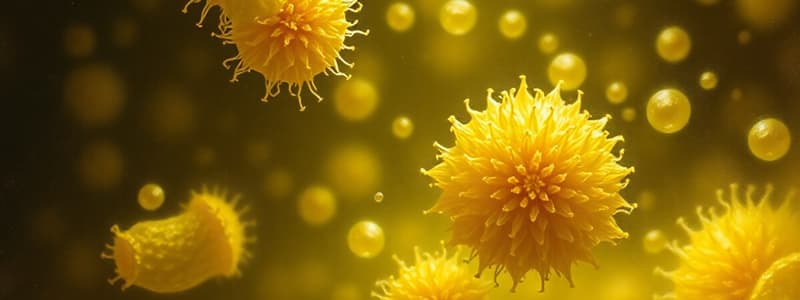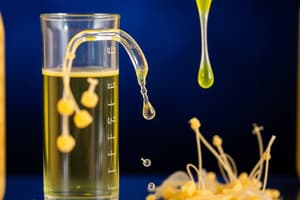Podcast
Questions and Answers
Which of the following is a characteristic of fungi?
Which of the following is a characteristic of fungi?
- They are motile and produce their own nutrients through photosynthesis.
- They are nonmotile and absorb nutrients from their surroundings. (correct)
- They are nonmotile, and reproduce by cell fission within a host cell.
- They are noncellular and replicate by taking over host cell metabolism.
What is the primary way that viruses cause disease?
What is the primary way that viruses cause disease?
- By directly destroying host cells through cell fission.
- By absorbing nutrients from their environment, causing a nutrient deficiency in host cells.
- By taking over the metabolism of a host cell to generate more viruses. (correct)
- By releasing toxins that disrupt the normal functioning of surrounding tissues.
Which historical event is most closely associated with the bubonic plague?
Which historical event is most closely associated with the bubonic plague?
- The Industrial Revolution
- The Renaissance (correct)
- The Age of Enlightenment
- The American Civil War
What was Lazzaro Spallanzani's primary contribution to our understanding of spontaneous generation?
What was Lazzaro Spallanzani's primary contribution to our understanding of spontaneous generation?
What key feature of Louis Pasteur's swan neck flask experiment helped to disprove spontaneous generation?
What key feature of Louis Pasteur's swan neck flask experiment helped to disprove spontaneous generation?
What significant contribution do microbes make to the Earth's atmosphere?
What significant contribution do microbes make to the Earth's atmosphere?
How is the scientific name of a microbe written?
How is the scientific name of a microbe written?
Which of the following is a characteristic of prokaryotic cells?
Which of the following is a characteristic of prokaryotic cells?
Which group of microbes is primarily known for being 'extremophiles'?
Which group of microbes is primarily known for being 'extremophiles'?
Which of the following describes a key attribute of protozoa?
Which of the following describes a key attribute of protozoa?
What is the primary function of algae in most food webs?
What is the primary function of algae in most food webs?
How are microbes classified?
How are microbes classified?
What is a key role of microbes in human health?
What is a key role of microbes in human health?
What was the main conclusion of Martinus Beijerinck's research on the tobacco mosaic disease?
What was the main conclusion of Martinus Beijerinck's research on the tobacco mosaic disease?
What is the significance of Sergei Winogradsky's research?
What is the significance of Sergei Winogradsky's research?
Which of the followings concepts are related to Lynn Margulis's endosymbiosis theory?
Which of the followings concepts are related to Lynn Margulis's endosymbiosis theory?
What is the key principle demonstrated by the use of cowpox matter to prevent smallpox?
What is the key principle demonstrated by the use of cowpox matter to prevent smallpox?
Why was the bacterial DNA polymerase found in Yellowstone National Park significant?
Why was the bacterial DNA polymerase found in Yellowstone National Park significant?
What is the significance of growing microbes in pure culture?
What is the significance of growing microbes in pure culture?
What was Carl Woese's major contribution to microbiology?
What was Carl Woese's major contribution to microbiology?
Which scientist first introduced the concept of using an antiseptic?
Which scientist first introduced the concept of using an antiseptic?
What was Rosalind Franklin's primary contribution to the discovery of the structure of DNA?
What was Rosalind Franklin's primary contribution to the discovery of the structure of DNA?
What is the primary goal of an antibiotic?
What is the primary goal of an antibiotic?
Which of the following is the best description for endosymbionts?
Which of the following is the best description for endosymbionts?
What is the primary contribution of Florence Nightingale to the field of medical microbiology?
What is the primary contribution of Florence Nightingale to the field of medical microbiology?
What did James Watson and Francis Crick discover about the structure of DNA?
What did James Watson and Francis Crick discover about the structure of DNA?
What is a major drawback of the widespread use of antibiotics?
What is a major drawback of the widespread use of antibiotics?
How does an attenuated microbe offer immunity?
How does an attenuated microbe offer immunity?
What did Joseph Lister's main contribution to medical practices?
What did Joseph Lister's main contribution to medical practices?
Which scientist identified penicillin?
Which scientist identified penicillin?
What is an example of epidemiology in action within the provided content?
What is an example of epidemiology in action within the provided content?
Flashcards
What is a Microbe?
What is a Microbe?
A microscopic living organism, typically a single-celled or multicellular organism that cannot be seen with the naked eye.
Prokaryotes
Prokaryotes
A living organism that lacks a nucleus, belonging to the Bacteria and Archaea domains.
Eukaryotes
Eukaryotes
A living organism that contains a nucleus, belonging to the domains Eukarya, including fungi, protozoa, and algae.
Pathogen
Pathogen
Signup and view all the flashcards
Microbiology
Microbiology
Signup and view all the flashcards
Extremophiles
Extremophiles
Signup and view all the flashcards
Species
Species
Signup and view all the flashcards
Scientific Classification
Scientific Classification
Signup and view all the flashcards
What are fungi?
What are fungi?
Signup and view all the flashcards
How do viruses reproduce?
How do viruses reproduce?
Signup and view all the flashcards
What is spontaneous generation?
What is spontaneous generation?
Signup and view all the flashcards
Explain Spallanzani's experiment
Explain Spallanzani's experiment
Signup and view all the flashcards
Describe Pasteur's experiment
Describe Pasteur's experiment
Signup and view all the flashcards
Germ Theory of Disease
Germ Theory of Disease
Signup and view all the flashcards
Epidemiology
Epidemiology
Signup and view all the flashcards
Pure Culture
Pure Culture
Signup and view all the flashcards
Koch's Postulates
Koch's Postulates
Signup and view all the flashcards
Vaccination
Vaccination
Signup and view all the flashcards
Attenuation
Attenuation
Signup and view all the flashcards
Immunity
Immunity
Signup and view all the flashcards
Immunization
Immunization
Signup and view all the flashcards
Antiseptics
Antiseptics
Signup and view all the flashcards
Antibiotics
Antibiotics
Signup and view all the flashcards
Culturable Microbes
Culturable Microbes
Signup and view all the flashcards
What is Microbiology?
What is Microbiology?
Signup and view all the flashcards
What are Extremophiles?
What are Extremophiles?
Signup and view all the flashcards
What are Lithotrophs?
What are Lithotrophs?
Signup and view all the flashcards
What is Nitrogen Fixation?
What is Nitrogen Fixation?
Signup and view all the flashcards
What are Endosymbionts?
What are Endosymbionts?
Signup and view all the flashcards
What is Endosymbiosis Theory?
What is Endosymbiosis Theory?
Signup and view all the flashcards
How is PCR Technology related to extremophiles?
How is PCR Technology related to extremophiles?
Signup and view all the flashcards
Study Notes
Microbes Shape Our History
- Microbes play crucial roles in shaping our atmosphere, geology, and energy cycles.
- They contribute to the air we breathe and fix nitrogen into usable forms for plants.
- Microbes produce essential vitamins, including B12, and are primary producers in food webs.
- Humans have numerous partnerships with microbes in food production, preservation, mining, and biotechnology.
- The vast majority of microbial interactions benefit humans.
What is a Microbe?
- Microbes are living organisms requiring microscopes.
- Sizes range from millimeters to 0.2 micrometers (viruses are smaller).
- Some microbes are visible without a microscope (e.g., amoebas).
- Others form complex multicellular assemblages (e.g., mycelia, biofilms).
- Some multicellular organisms require microscopes.
Defining Species
- Microbes are categorized as species based on common genes and traits.
- Scientific names include genus (capitalized) and species (lowercase) italicized (e.g., Escherichia coli).
- Classification is based on genetic relatedness.
- Relatedness is assessed through comparing DNA sequences in the genome.
- The presence or absence of a membrane-enclosed nucleus is a major classification differentiator.
Eukaryotic vs Prokaryotic
- Prokaryotes lack a nuclear membrane. Bacteria and archaea are examples.
- Eukaryotes possess a nuclear membrane. Fungi, protozoa, and algae are examples.
- Bacteria are 0.2-20 μm in size, ubiquitous and capable of forming single cells, filaments, or communities.
- Archaea are genetically distinct from bacteria and are often considered extremophiles (e.g., methanogens).
What is a Microbe? -- Eukaryotic
- Protozoa are motile single-celled organisms, either free-living or parasitic.
- Algae contain chloroplasts for photosynthesis and form the base of the food web.
- Fungi are non-motile, absorb nutrients, and can grow as single cells or filaments.
What is a Microbe? -- Other
- Viruses are not cellular but contain genetic material (DNA or RNA) that takes over a host cell's metabolism to replicate.
- Viruses can cause illnesses.
Disease and Microbes
- Microbes have profoundly affected human history.
- Diseases like leprosy, smallpox, bubonic plague, and HIV have caused widespread devastation.
- Historical figures, like Catherine of Siena, have been impacted by those diseases.
- Medical advancements like microscopes, spontaneous generation theories, and germ theory have dramatically shaped our understanding of microbes.
- Epidemiology has evolved in efforts to understand the spread of disease
Microbes in Our Environment
- Microbial ecologists have illustrated the vital role microbes play in geochemical cycles (e.g., nitrogen fixation).
- Microbes are pivotal in ecosystems; some microbes demonstrate symbiotic relationships.
- Examples of endosymbiosis include endosymbionts within animals and plants.
The Discovery of Viruses
- Viruses were discovered by researchers studying tobacco mosaic disease.
- These were shown to be much smaller than microbes.
- Crystallization methodology was key in the early understanding of viruses.
- The discovery of viruses led to new fields in biotechnology and pharmacology
The DNA Revolution
- The X-ray crystallography of DNA, pioneered by Dorothy Hodgkin, detailed the structure of DNA and provided evidence of a double helix structure.
- Rosalind Franklin's key X-ray micrographs and data were critical for determining the DNA double helix structure.
Antiseptics and Antibiotics
- Development of penicillin, an antibiotic, revolutionized treatment and prevention of microbial infection.
- Alexander Fleming's accidental discovery of penicillin marked a monumental medical advancement.
- Antiseptics and antibiotics have enabled more efficient and successful interventions to infection
- Antibiotic resistance has emerged as a significant threat to human and animal health.
Studying That Suits You
Use AI to generate personalized quizzes and flashcards to suit your learning preferences.





